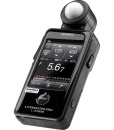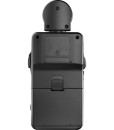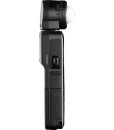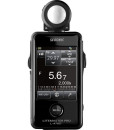Shop/Lighting and Studio/Light Meters
Sekonic Litemaster Pro L-478DR Light Meter
₱20,000.00
- Color Touch Screen Interface
- Still, Cine, Incident, Reflected, Flash Exposure Meter
- Wireless Flash Power Control
- Custom Exposure Profiles and Calibration
- Flash Exposure Analyzing Function
- Adjustable Menu Navigation
- Retractable and Removable Lumisphere
- AAA Battery Power Source
The Sekonic Litemaster Pro L-478DR Light Meter is an incident and flash meter featuring a color touch screen interface. The touch screen-based navigation lends itself to a highly intuitive and efficient workflow, allowing you to quickly modify exposure settings and navigate menus. This meter is also highly versatile and capable of measuring flash, incident and reflected light for still, HD video, or cine applications.
The L-478DR can be customized or adapted to your own specifications; depending on the metering modes you use most often, you can hide certain modes to create a more streamlined menu system. Exposure constants include shutter speed, f/-number, ISO, shutter angle, and frame rate; and the exposure variable can be decided upon depending on the situation you are working in. Illuminance and luminance values can also be taken, which are measured in footcandles/lux or candela per square meter/foot-lamberts, respectively. For more fine-tuned results, you can create and input personal profiles, allowing the meter to display exposure settings in accordance with your specific camera’s dynamic range and clipping points.
When working with wireless flash metering, the L-478DR has the ability to wirelessly control the power of your flashes via PocketWizard ControlTL technology. Pairing this technology within a light meter enables you to wirelessly adjust the power output from full to 1/64th power for either Nikon or Canon strobes that are mounted to a PocketWizard FlexTT5 transceiver (optional), or to certain studio strobe packs using PocketWizard ControlTL receivers. It will also trigger standard PocketWizards like the Plus or MultiMax series, or any strobe with built-in PocketWizard support. 20 standard channels and 3 CTL zones are available for use with strobes, and your wireless settings can be modified through the menu settings. Depending on the number of lights you are using, you can alter the output of each device from the meter and take a subsequent reading from the main screen. Once each flash group has been measured individually, you can determine your overall exposure settings and transfer those settings to your camera*.
Other settings available include the ability to memorize up to 10 different exposure readings in order to refer back for comparative overall measurements. The AVE/EV setting allows you to make one master exposure reading and have subsequent readings displayed as differential values based on the master exposure value. When working with flash metering, the flash exposure values can be expressed as a percentage of the flash-to-ambient light, giving you the ability to more easily alter and previsualize lighting ratios. Filter compensation and exposure compensation settings can also be applied in order to remove the necessity to apply different filter factors after a meter reading has been taken.
*Note: When using the L-478DR for wireless power control, the applicable PocketWizard units must be updated to the latest firmware. Furthermore, the Mini TT1 or Flex TT5 radio (optional) must be set to “No Change (Trigger Only)” mode. This will allow the L-478DR to function as the master controller, and ensure that your camera will not alter the power settings of the flash groups.
- Color Touch Screen Interface and Design
-
- The touch screen provides a more intuitive style of navigation and allows you to simply touch the settings you wish to adjust. Menu navigation is intuitive and the handling of various configurations becomes an expedited process.
- Simple visual layout provides a clear view of your exposure setting and permits customization in regard to the information you wish to be displayed (including a choice of analog exposure scales (EV or f/-stops); 1, 1/2, or 1/3 step increments; the inclusion of 1/10 stops; and the option to hide metering modes you do not use frequently).
- One physical menu button provides access to a more in-depth menu system that is then navigated through the touch screen. This menu allows for you to program exposure profiles and modify custom settings for your meter.
- Measure and memory buttons are located on the side of the device for recording and initiating exposure readings. A PC sync terminal is located on the bottom of the device for direct, corded flash metering. A USB terminal is located on the side and provides a connection point to your computer for firmware updates and for loading exposure profiles to your meter. The attached light receptor features a retractable Lumisphere that can be rotated 90° clockwise or 180° counter-clockwise. It is also removable in order to facilitate the use of optional attachments.
- Wireless Flash Power Control
-
- Wirelessly control and modify the power output of PocketWizard-mounted/enabled strobes or flashes directly from your meter.
- Three sliders allow you to dial up or dial down flash power from full to 1/64th power directly from the meter.
- Up to three zones can be managed; when working with more than one zone, determine each zone’s values individually in order to establish desired lighting ratios, then an overall exposure sum will be determined.
- Versatility Between Metering Methods
-
- Ability to measure incident or flash light and display exposure readings as f/-numbers, shutter speeds, or ISO settings for use with still imaging, HD video, and cine uses. Exposure constants also include frame rate and shutter angle for a variety of motion uses.
- Also capable of measuring illuminance as footcandles/lux or luminance as candela per square meter/foot-lamberts.
- Flash metering can display the percentage of flash-to-ambient light within the scene for precise lighting ratios.
- Comparative metering can be accomplished by using the AVE/EV function; allowing you to set a standard reading and have subsequent readings shown as the difference in exposure value.
- Cinematic modes offer creative options for setting frame rates between 1 to 1000fps or shutter angles from 1° to 358°.
- Filter compensation mode enables you to directly apply the effects of filters to your exposure reading. Up to four different filter factors can be applied at once, and up to 30 different filter factors can be stored for use (24 common filters are pre-programmed, including CTB, CTO, ND, +/- green, and 85 amber filters).
- Custom Profiling
-
- You can enable and disable different metering modes from showing up in menus, allowing you to configure the meter to your own personal workflow.
- Calibration and custom profiling can be accomplished in accordance to your own personal camera by executing a series of exposure tests, processing the tests through Sekonic’s Data Transfer Software (included), and outputting the results as a personal profile for use with your meter. These personal profiles confine your meter to work within your specific camera’s dynamic range (up to 10 distinct profiles can be saved). Profiles can also be modified or created directly through the meter.
- Display Range
-
- ISO- ISO 3 to 409600 (in 1/3 steps)
- Shutter Speed- Ambient: 30 min. to 1/6400 sec. (in 1, 1/2, and 1/3 steps), 1/200 and 1/400 sec. also available
Flash: 30 min. to 1/1000 sec. (in 1, 1/2, and 1/3 steps), 1/75, 1/80, 1/90, 1/100, 1/200, and 1/400 sec. also available - Aperture- f/0.5 to f/162.2 (in 1/3 steps)
- Frame Rate (f/s)- 1 to 1000 (20 types other possible settings)
- Shutter Angle- 1° to 358° (20 types other possible settings)
- EV- EV -27.9 to 55.8 (only effective with ambient light)
- Analog- T scale: 4 to 1/2000 sec. (in 1/3 steps)
F scale: f/1.0 to f/90 (in 1/3 steps)
EV scale: EV -3 to 3 (incident light, in 1/3 steps) / EV -7 to 7 (reflected light, in 1/3 steps)
Illuminance lux: 0 to 50,000 lux
Illuminance fc: 0 to 5,000 fc
Luminance cd/m2: 0 to 2,500 cd/m2
Luminance fl: 0 to1,000 fl - Contrast- EV -9.9 to 9.9 (in 1/10 steps)
- Filter Compensation- EV -5 to 5 (in 1/10 steps)
- Compensation- EV -9.9 to 9.9 (in 1/10 steps)
























